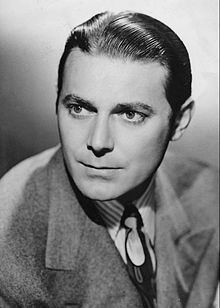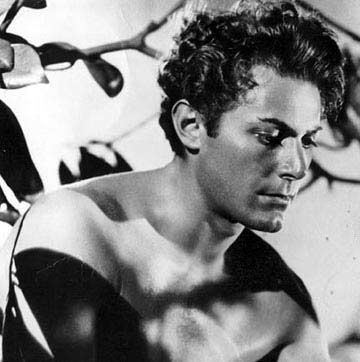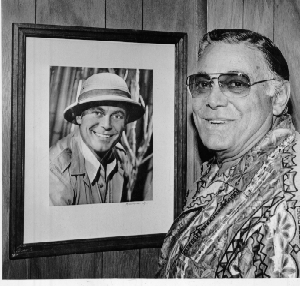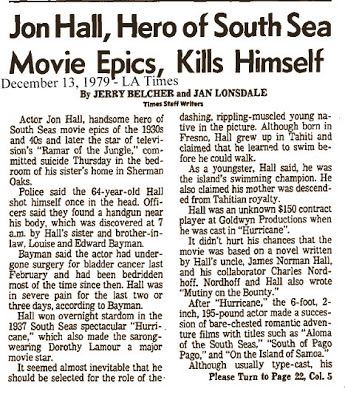Occupation Actor Parents Felix Locher Role Film actor | Name Jon Hall Years active 1935-1965 | |
 | ||
Full Name Charles Felix Locher Died December 13, 1979, North Hollywood, California, United States Movies and TV shows Similar People Frances Langford, Arthur Lubin, Dorothy Lamour, Raquel Torres, Felix Locher | ||
The black white sessions jon hall faithfully
Jon Hall (February 23, 1915 – December 13, 1979) was an American film actor known for playing a variety of adventurous roles, as in 1937's The Hurricane, and later when contracted to Universal Pictures, including Invisible Agent and The Invisible Man's Revenge and six movies he made with Maria Montez. He was also known to 1950s fans as the creator and star of the Ramar of the Jungle television series which ran from 1952 to 1954. Hall directed and starred in two 1960's sci-fi films in his later years, The Beach Girls and the Monster (1965) and The Navy vs. the Night Monsters (1966).
Contents
- The black white sessions jon hall faithfully
- Cosmo s 15 hottest hunks ever jon hall
- Biography
- Charles Locher
- Lloyd Crane
- The Hurricane 1937 and Stardom
- Universal
- Sam Katzman
- Television
- Non Acting Career
- Personal life
- Death
- Hollywood Walk of Fame
- References

Cosmo s 15 hottest hunks ever jon hall
Biography

Born Charles Felix Locher in Fresno, California, and raised in Tahiti by his father, the Swiss-born actor Felix Locher, he was a nephew of writer James Norman Hall, the author, along with Charles Nordhoff, of the novel Mutiny on the Bounty.

Hall originally intended to go into the diplomatic service and was educated in England and Switzerland. But a friend from Tahiti, writer Gouvernor Morris, suggested he try acting.
Charles Locher

Hall began in his career under the name "Charles Locher". His first performance was in a local theatre production of M'Lord the Duke, replacing Robert Taylor who had just signed to MGM.

He appeared in Murder on a Mountain on stage at the Bliss Hayden Little Theatre in Beverly Hills.. This earned him a contract at Warner Bros. He followed it with What? No Yacht? at the Bliss Hayden Nothing appears to have happened with the Warners contract but his first film was Women Must Dress (1935) at Monogram.

In April 1935 he signed with 20th Century Fox for a role in Charlie Chan Goes To Egypt. He ended up not appearing in that movie but did have an uncredited bit in Here's to Romance and play the romantic male lead in Charlie Chan in Shanghai (1935). After that the studio released him from his contract.

In Hall's words "for the next three years I took whatever jobs in pictures they'd give me." He had support roles in the Westerns The Mysterious Avenger (1936), at Columbia, and Winds of the Wasteland (1936), with John Wayne at Republic Pictures, and the serial The Clutching Hand (1936). He had the lead in a low budget adventure movie The Lion Man (1936), based on a novel by Edgar Rice Burroughs. He was rejected for the lead of the Flash Gordon serial .
Lloyd Crane

He changed his screen name to "Lloyd Crane" and in 1936 signed a contract with Major Pictures, a company run by producer Emmanuel Cohen who distributed through Paramount. Other actors who had deals with Cohen included Bing Crosby, Mae West, and Gary Cooper. He made two pictures for Cohen, Mind Your Own Business (1936) and The Girl from Scotland Yard (1937). Then Cohen dropped him.
The Hurricane (1937) and Stardom
Samuel Goldwyn was preparing a big budget spectacular, The Hurricane (1937), based on a novel by Nordhoff and Hall and directed by John Ford. They were having trouble finding someone to play the native whose wrongful imprisonment is the focus of the drama until Ford introduced Hall to Goldwyn. Hall was signed to a long term contract to Goldwyn, and cast in the film, which was a big success.
Goldwyn paid him $150 a week, eventually rising to $200 a week.
Hall then spent the next two and a half years idle under his contract as Goldwyn - who only made a few movies a year - contemplated what to do with him. There was some talk of a sequel to The Hurricane, of playing the lead in Golden Boy, of Black Gold a film for Goldwyn about firefights in Oklahoma; Fleet's In for Goldwyn; Tahiti based on a book by Somerset Maugham, for Goldwyn. Alexander Korda wanted Hall for Thief of Bagdad. These films were either not made or made without Hall.
Discussing the delay Hall said "At first it's alright because you tell [people]... what you believe to be true, that the studio is trying to find you a right script. But after a year, after a year and a half, after two years, you start to go nuts. You find yourself ducking across the street to avoid people who will ask you what you are doing."
After two and a half years inactive, Hall made three films in quick succession: Sailor's Lady (1940), a comedy with Nancy Kelly that was developed by Goldwyn and sold to 20th Century Fox; South of Pago Pago (1940), a South Seas adventure for producer Edward Small; and Kit Carson (1940), in the title role, again for Edward Small.
Dorothy Lamour had gone to Paramount, and they reunited her with Hall in the South Seas tale, Aloma of the South Seas (1941). He stayed in that genre for The Tuttles of Tahiti (1942) with Charles Laughton at RKO, from a novel by Nordhoff and Hall.
Universal
Goldwyn agreed to share Hall's contract with Universal Pictures who put him in a supporting role in Eagle Squadron (1942), produced by Walter Wanger and directed by Arthur Lubin, and a huge hit. They gave him the lead in Invisible Agent (1942), the fourth in their "Invisible Man" series.
Wanger called upon Hall for another movie at Universal, a big budget "exotic" spectacular co-starring Maria Montez and Sabu, Arabian Nights (1942). It was Universal's first movie in colour in years, and was a massive hit.
Universal promptly reunited Montez, Hall and Sabu in two more films: White Savage (1943), directed by Lubin, and Cobra Woman (1944), directed by Robert Siodmak.
Paramount borrowed Hall to play a film star in the musical Lady in the Dark (1944), playing the role originated by Victor Mature on Broadway.
Back at Universal he returned to the Invisible Man series with The Invisible Man's Revenge (1944), making him the only actor to have portrayed an Invisible Man more than once in the original Universal series.
Hall was meant to be reunited with Montez and Sabu for three more technicolor films. However Sabu was drafted in the army and was replaced by Turhan Bey for Ali Baba and the Forty Thieves (1944), directed by Lubin. Bey was going to reteam with Hall and Montez in Gypsy Wildcat (1944) but was needed for another film, and was replaced by Peter Coe. Hall appeared in a comedy, San Diego, I Love You (1945), then was reunited with Montez and Bey in Sudan (1945) - although this was the one Hall-Montez film where she wound up with someone else at the end, Bey.
Hall appeared in a comedy Men in Her Diary (1945) filmed in early 1945 then went into the army. He was out of the army by April 1946 and made a pair of Westerns, The Michigan Kid (1947) and The Vigilantes Return (1947). After this he made no further films for Universal, although he was still under contract to Goldwyn.
Sam Katzman
Hall went on to make a number of films for producer Sam Katzman who had a set-up at Columbia Pictures. Their association began with Last of the Redskins (1947), an adaptation of Last of the Mohicans (1947), where he had to be borrowed from Sam Goldwyn. He followed it with The Prince of Thieves (1948), playing Robin Hood, and The Mutineers (1949).
Hall was in three films for director William Berke, Zamba (1949), an adventure tale, Deputy Marshall (1949), a Western, and On the Isle of Samoa (1950), a South Seas tale.
He was meant to appear in The Last of the Buccaneers for Katzman but Paul Henreid played the role. In June 1950 he signed a new three picture contract with Katzman and his wife Frances Langford signed a two picture contract. They both starred in Hurricane Island (1951), and Katzman scheduled Thief of Damascus for the two of them. Henreid wound up starring in that instead; Hall made made two Westerns, When the Redskins Rode (1951), and Brave Warrior (1952). He also made China Corsair (1951) for Columbia.
It was back to Katzman for Last Train from Bombay (1952).
Television
Jon Hall is perhaps best remembered by later audiences as the star of the television series Ramar of the Jungle, which ran from 1952 to 1954.
He made a pilot for an unsold series, Knight of the South Seas for his own company, Lovina Productions. It was not picked up for series but the pilot was edited into a film, Hell Ship Mutiny (1957).
He returned to feature films with Forbidden Island (1959), made at Columbia by Charles B. Griffith. He said he wished to follow it with three more movies, two set in the Orient and one a Western. However the film was not successful and it was a number of years before Hall appeared in another movie.
Hall made his final two television appearances on Perry Mason; in 1963, he played Max Randall in "The Case of the Festive Felon," and in 1965, he played Lt. Kia in "The Case of the Feather Cloak." He directed and starred in the 1965 cult horror film The Beach Girls and the Monster.
Non Acting Career
Jon was an inventor and highly skilled aviator. He held patents on an underwater camera, optivision lenses and the design of the hulls of PT boats for the US Navy.
He shot some additional footage for The Navy vs. the Night Monsters (1966).
With his father, he developed the Locher-Hall Telecurve map, a revolutionary cartographic device.
During the 1970s he ran a camera lens firm, Optivision Co. of Santa Monica.
Personal life
Hall was married to singer Frances Langford from 1934 until 1955, and also later twice married and divorced actress Raquel Torres (m 1959).
In 1944, he took part in "the battle of the balcony," a fight between Hall and big band leader Tommy Dorsey.
Death
Hall was diagnosed with incurable bladder cancer which caused him extreme pain. He committed suicide on December 13, 1979.
Hollywood Walk of Fame
Hall has two stars on the Hollywood Walk of Fame, for Motion Pictures at 1724 Vine Street and for television at 6933 Hollywood Boulevard.
